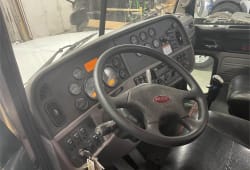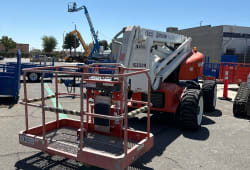Maximizing Equipment Productivity in Construction: Calculations, Key Factors & Expert Tips
4 Min read
)
May 26, 2025
Equipment productivity in construction refers to the efficiency with which machinery performs specific tasks on a job site. It plays a vital role in ensuring that projects stay on schedule and within budget. With accurate productivity calculations and proactive management, construction companies can optimize their resources, reduce downtime, and improve profitability. In this blog post, we’ll cover how to measure equipment productivity, factors that influence it, and strategies to improve it on your construction projects.
What Is Equipment Productivity?
Equipment productivity is typically defined as the amount of work completed by a piece of equipment in a given time period. For example, how many cubic yards of earth an excavator can move in an hour. High equipment productivity means less time and labor spent on tasks, which directly translates into cost savings.
How to Calculate Equipment Productivity
:format(webp))
To effectively manage productivity, you need to measure it. The basic formula for equipment productivity is:
Productivity = Output / Input
Where:
Output = amount of work done (e.g., volume of soil moved, square footage paved)
Input = time taken or energy consumed (e.g., hours, fuel)
Examples:
An excavator moves 180 cubic yards of soil in 6 hours:
Productivity = 180 / 6 = 30 cubic yards/hour
A concrete pump lays 500 square feet in 5 hours:
Productivity = 500 / 5 = 100 square feet/hour
Using software tools or telematics systems can help track these metrics in real time, leading to better forecasting and planning.
Key Factors Affecting Equipment Productivity in Construction
Several factors can influence equipment productivity on a construction site:
Operator Skill and Experience: Skilled operators can run machines more efficiently and safely.
Equipment Condition: Well-maintained machines perform better and have less downtime.
Type of Equipment: The right machine for the right task can drastically improve output.
Site Conditions: Poor weather, soft ground, or tight spaces can reduce efficiency.
Material Characteristics: Dense or difficult-to-handle materials take longer to move or install.
Maintenance Practices: Preventive maintenance reduces unexpected breakdowns.
Scheduling and Logistics: Poor planning leads to idle time and underused machines.
Strategies to Improve Equipment Productivity
Improving equipment productivity isn’t just about working faster—it’s about working smarter. Here are a few proven strategies:
Invest in Operator Training: Ensure your staff knows how to get the most out of the equipment.
Use Telematics and Monitoring Tools: Track machine usage, fuel consumption, idle time, and more.
Conduct Regular Preventive Maintenance: Keep machines in top condition to avoid downtime.
Optimize Equipment Selection: Choose the most suitable equipment for the task and site conditions.
Improve Site Layout and Logistics: Minimize travel time and bottlenecks.
Using Technology to Track and Boost Productivity
:format(webp))
Construction management software and telematics systems can significantly enhance your ability to monitor and improve equipment performance. These tools offer:
Real-time tracking of usage and productivity
Alerts for maintenance needs
Data analysis for performance trends
Integration with scheduling and cost control systems
Popular platforms like Trimble, HCSS, and CAT VisionLink help companies make data-driven decisions to increase efficiency.
Case Study: Boosting Equipment Productivity on a Jobsite
A medium-sized contractor noticed extended idle time with their fleet of backhoes. After implementing telematics, they discovered that poor coordination between material delivery and excavation scheduling was causing the delays. By adjusting their workflow and using real-time data, they increased productivity by 22% in just two months.
Common Mistakes That Lower Equipment Productivity
Even with the right tools, common mistakes can hurt your bottom line:
Underutilizing Equipment: Machines sitting idle still cost money.
Skipping Maintenance: Leads to breakdowns and costly repairs.
Lack of Communication: Delays and misunderstandings can reduce efficiency.
Poor Job Planning: Inadequate scheduling or logistics planning can create workflow bottlenecks.
Conclusion
Maximizing equipment productivity in construction is essential for maintaining competitive project timelines and controlling costs. By understanding how to calculate productivity, recognizing the factors that affect it, and applying technology and strategy, you can significantly improve your construction site performance. Start tracking your equipment metrics today and make informed decisions that boost your ROI.
FAQs
What is equipment productivity in construction? It measures how efficiently construction equipment completes specific tasks, often represented in units of work per hour.
How do you calculate equipment productivity? Divide the output (e.g., volume or square footage) by the input (e.g., time or fuel used).
What are the main factors affecting equipment productivity? Operator skill, machine condition, site layout, material type, and maintenance practices are key.
Can software improve equipment productivity? Yes, telematics and construction software provide real-time insights and data that help improve decision-making and efficiency.
Why does equipment productivity matter? Better productivity reduces costs, improves timelines, and maximizes resource utilization on construction projects.

Caleb Woods is an experienced content specialist and an editor at Boom & Bucket, blending his journalism background with expertise in the heavy equipment industry. He delivers engaging, informative content to help professionals stay informed and make smarter decisions in the machinery market.











